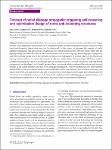Item Infomation
Full metadata record
| DC Field | Value | Language |
|---|---|---|
| dc.contributor.author | Hao, Gong | - |
| dc.contributor.author | Jianhua, Liu | - |
| dc.contributor.author | Huihua, Feng | - |
| dc.date.accessioned | 2023-04-14T08:16:03Z | - |
| dc.date.available | 2023-04-14T08:16:03Z | - |
| dc.date.issued | 2022 | - |
| dc.identifier.uri | https://link.springer.com/article/10.1007/s40544-022-0618-5 | - |
| dc.identifier.uri | https://dlib.phenikaa-uni.edu.vn/handle/PNK/7954 | - |
| dc.description | CC BY | vi |
| dc.description.abstract | Self-loosening of bolted joints can occur in a vibration environment, and it may induce bolt fatigue fracture with catastrophic consequences. It is essential to clarify the self-loosening mechanism, based on which novel anti-loosening thread structures can be developed. In this paper, we propose the concept of radial slippage propagation and provide new insights into the self-loosening process. The new theory states that the slippage along the radial direction of the thread surface induces more slippage areas (slippage propagation), and self-loosening occurs due to the dynamic evolution and propagation of contact states on the thread and bearing surfaces with an increase in the number of vibration cycles. | vi |
| dc.language.iso | en | vi |
| dc.publisher | Springer | vi |
| dc.subject | Self-loosening of bolted joints | vi |
| dc.subject | radial slippage propagation triggering self-loosening | vi |
| dc.title | Concept of radial slippage propagation triggering self-loosening and optimisation design of novel anti-loosening structures | vi |
| dc.type | Book | vi |
| Appears in Collections | ||
| OER - Kỹ thuật điện; Điện tử - Viễn thông | ||
Files in This Item:

